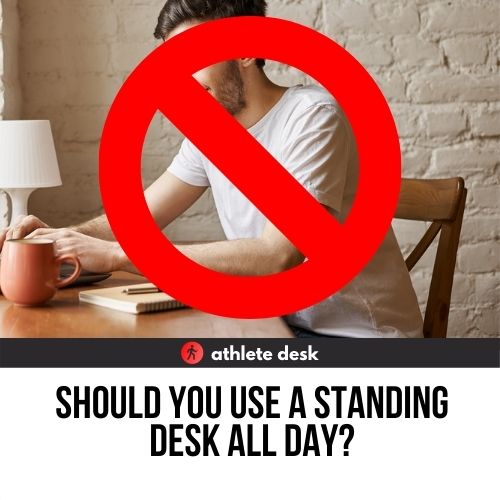Standing desks have become increasingly popular over the last few years.
There are tons of negative effects of sitting too much, but are standing desks actually healthier?
And is it okay to stand at one all day?
Let's find out!

Negative Effects of Sitting
In order to see the benefits of standing it is important to look at the ways that sitting too much can harm your health. Then we can better see the ways to properly utilize your standing desk and whether you should use a standing desk all day.
Sitting too much can have some detrimental effects on our overall health. Sitting uses less energy than standing and moving around and increases the risk of obesity, high blood pressure, high blood sugar, and atypical cholesterol levels. Research also indicates a correlation with heart disease and cancer risks.
Sitting for a few minutes here and there doesn’t seem to affect health in a profound way. However, any extended amount of sitting, like sitting at a desk all day for work, can harm you. In fact, research indicates that we require an hour to an hour and fifteen minutes of moderate exercise every day in order to combat the negative effects of sitting too much.

Sitting can also negatively impact your muscle mass and structure. It can also weaken your hip and back muscles. These negative effects of sitting can lead to pain. Sitting can also cause unwanted weight gain. Not only does it burn less calories than standing, but muscle movement can help our bodies digest sugars and fats. Inefficient digestion can cause an influx of weight.
Long periods of sitting can increase our chances of heart disease. In fact, some experts claim that those who sit for extended periods have a 147% higher risk of heart attacks or strokes.
Those with a sedentary lifestyle also develop increased insulin resistance and diabetes. Studies show that more sitting can cause up to 112 percent higher risk of diabetes.
As you can see, it is probably best to avoid extended periods of sitting. However, that doesn’t necessarily mean standing for 8 hours a day is recommended.
Read More >> Ergonomics in the Workplace [Ultimate Guide]
How Much Should You Stand?
Standing desks can reduce the amount of time we spend sitting. It can even combat the negative effects of a sedentary lifestyle. Standing can even reduce back and neck pain associated with sitting, especially if done in an ergonomically correct way. Some studies show a 32 percent reduction in back pain after just several weeks of using a standing desk. Conversely, moving back to a traditional sitting desk correlated with the return of back and neck pain.
Additionally, some studies show an increase in productivity and focus while standing. Exercise has also been shown to have a positive impact on mental health and a reduction in anxiety and depression. Some people even report more energy than they had before implementing a standing desk while they were working.
Standing can burn additional calories. Some research shows that it only burns minimal calories, however other research shows a substantial difference in calories burnt and blood sugar. Standing immediately after eating lunch can drastically improve blood sugar levels. Standing can also help you move and walk more which definitely increases the amount of calories you burn during the day.
All of these benefits of standing, and reducing the harm from sitting too much, may lead to an increased lifespan. In fact, you can even increase your life expectancy a full two years by just reducing your sitting time.
However, standing too much can also have some side effects. Some people notice elevated foot, back, leg, and neck pain when they switch to a standing desk. Instead of switching from only sitting to only standing, it is best to slowly adjust and increase the time you spend standing over time.
Standing too much can even increase the chances that a person will develop heart disease. Instead of choosing standing or sitting, it is best to switch between sitting and standing. It is also a good idea to move around and take short walks periodically throughout each day.
Read More: Does Insurance Cover a Standing Desk?
How to Properly Use a Standing Desk
Standing desks can help you avoid a sedentary lifestyle, but there are some ways to utilize them in order to reap the health benefits.
Standing - Sitting Ratio
Research suggests that you should combine sitting and standing in order to avoid the health risks associated with each one. In fact, a combination of sitting and standing can be much healthier than just one or the other.
More studies need to be done, but it seems that a 1:1 ratio or a 2:1 ratio of sitting to standing are the best for health. Therefore, you should try to alternate between sitting and standing every half hour to hour during the workday. This means that you should stand for a half hour to an hour for every hour that you sit.
Some people like to use an alarm to remind them to alternate. While this can be very beneficial when you are adjusting, it can actually negatively affect your productivity. If you do choose to use an alarm, find your sweet spot so you can adjust during mental breaks as much as possible.
Ergonomics
Sometimes people don’t use standing desks correctly. An ergonomic posture should be attained to comfortably use a standing desk and improve overall health. The height of the desk and the position of the computer screen are important and when done correctly, encourage good posture instead of bad posture.
The standing desk should be adjusted to around the height of your elbows. A good way to check is to adjust it until you can reach out and your forearms are parallel with the floor. The computer screen should be around 2 feet, give or take, away from your eyes and be at the proper degree or angle to allow for eye level visual contact of the display. You should never have to tilt your neck!
A negative tilting keyboard may also be a good idea. There are also arm rest available that can attach to your desk. When you are working, always try to keep your back as straight as possible. Keep your wrists straight and parallel to the desktop so you don’t have to bend them too much or move them very often. Your wrists should rest comfortably onto your keyboard.
Also, when you are sitting at your desk, you should have the height of the chair in the best position. The cushion should be parallel with the back of your thighs while your feet are flat on the floor. Just like with standing, the desktop should be at elbow height. You may even want to invest in an ergonomic chair.
It may also be best to adjust your materials, such as your mouse, pen, and paper, to easily accessible locations so that you do not have to bend or move your back to reach them.
Finally, to make your increased standing time comfortable it may be best to buy new shoes or purchase an anti fatigue mat to stand on. You don’t want to have foot pain that drives you back to unhealthy sitting habits. You can even buy standing desk mats that are made specifically to combat fatigue.
Read More >> Top 5 Best Pneumatic Standing Desks (2021 Review)
Should You Use a Standing Desk All Day?
So, in conclusion, sitting can severely impact your health from an increase in heart disease and cancer risk to a reduction in life expectancy. Standing can combat these negative effects of a sedentary lifestyle. However, too much standing can come with a cost as well but is in many ways healthier and helps promote overall increased physical activity.
If you switch to a standing desk, it is best to ease into it first. Increase the time by a half hour each day until you reach the recommended ratio of either 1:1 or 2:1 sitting to standing. In addition, you should move around periodically throughout the day by stretching or walking. Finally, you need to always make sure that you are positioned in an ergonomically beneficial position in regards to your desk and your computer screen.








